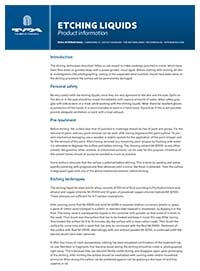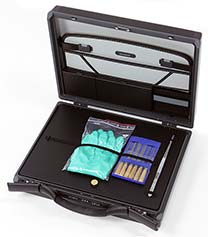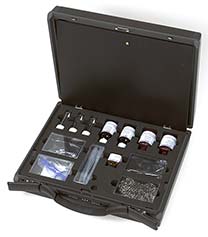| C - 15000 | 1 | Box with plasticine, dam clay |
| C - 25000 | 1 | Forceps, SS, with rounded points, 26 cm long |
| C - 76000 | 3 | Plastic bottles with stopper, 9.5 cm high, internal diameter 22 mm |
| C - 78000 | 5 | Disposable pipet, plastic, 3 ml |
| C - 82000 | 4 | Polystyrene boxes with lid, 11.5 x 7.5 x 3 cm |
| F - 101000 | 1 | Package absorption lint (cotton) |
| M - 31000 | 1 | Etching liquid for steel (Fry's formulation), 100 ml |
| M - 32000 | 1 | Cleaning solvent for metal degreasing (trichloroethylene), 100 ml in glass bottle |
| M - 32100 | 1 | Copper chloride hydrate, 50 g |
| M - 32200 | 1 | Etching liquid for aluminum, sodium hydroxide-based |
| M - 32300 | 1 | Etching liquid for aluminum, nitric acid-based |
| M - 33100 | 1 | Steel wool scouring pad |
| M - 34000 | 1 | Assortment of sandpaper |
| N - 8500 | 1 | Set of 6 key files, in case |
| V - 102000 | 1 | Pair of chemical-resistant gloves |
| V - 107000 | 1 | Clamping forceps, polypropylene, chemical-resistant |
Introduction
The etching techniques described futher on are meant to make markings punched in metal, which have been filed down or grinded away with a power grinder, visual again.
Before starting with etching, all other investigations (like photographing, casting of the suspected serial number e.g. with Silmark) should have been done. In the etching procedure the surface will be permanently damaged.
Personal safety
Be very careful with the etching liquids, since they are very agressive to the skin and the eyes. Spills on the skin or in the eyes should be rinsed immediately with copious amounts of water. Wear safety goggles with side screens or a mask while working with the etching liquids. Wear chemical resistant gloves as protection of the hands.
It is recommended to work in a fume hood, if practical. If this is not possible, provide adequate ventilation or work with a local exhaust.
Also pay attention to the disposal of your waste (used cotton e.g.) to avoid damage to property or wounding of persons. Acid waste can be neutralized with washing soda (sodium carbonate decahydrate).
Pre-treatment
Before etching, the surface (also that of punched in markings) should be free of paint and grease. For the removal of paint, ordinary paint remover can be used, after having degreased the paint surface. To prevent mechanical damaging, use a wooden (E-70000) or plastic spatula (bijv. E-12000) for the application of the paint stripper and for the removal of the paint.
After having removed any remaining paint stripper by flushing with water, it is advisable to degrease the surface just before etching. The cleaning solvent M-32000, or any other solvent, like gasoline, ether, acetone, or chlorinated solvents, can be used for this purpose.
Inhalation of the solvent fumes should of course be avoided as much as possible.
Some authors advocate that the surface is polished before etching. This is done by sanding and subsequently polishing with progressively finer abrasives until a mirror like finish is obtained. Then the surface is degreased again with any of the above mentioned solvents, before etching.
Etching techniques
Steel and its alloys
The etching liquid for steel and its alloys consists of 100 ml of fluid according to Fry (hydrochlorid acid, ethanol and copper chloride, M-31000) and 50 gram of powdered copper chloride hydrate (M-32100). These amounts are sufficient for 5-7 number restorations.
After pouring some fluid M-31000 and solid M-32100 in separate shallow containers (plastic or glass), a piece of cotton wool (clamped in a plastic clamping forceps V-107000 or stainless steel forceps) is moistened, by dipping it in the fluid. The damp swab is subsequently dipped in the container with powder, so that some of it sticks to the swab. Then brush over the surface that has to be treated and keep it moist this way. After having thus treated the surface for 5 to 10 minutes, dry the surface with a clean cotton swab. Then brush the surface for some time with a swab that has only be moistened with the fluid M-31000. Treatment of the surface with fluid M-31000, alternatingly with and without powder M-32100, is continued untill the desired results have been obtained. If, after four hours at room temperature, nothing has been visualized continuation of the treatment has no use.
Numbers or fragments that become visual during the etching should be noted or photographed right away. This is because they can become faintly visible during, and disappear again upon prolonging of the etching.
After etching the surface should be neutralized with running water and/or household ammonia. After drying the surface can be protected against rust by applying a thin layer of acid free vaseline or oil.
Acceleration of etching
Etching can be accelerated with one of the following methods:
- Heating of the surface to be etched with a hot air gun. The rule is that how warmer the surface, how faster the etching will be. Since etching is a chemical process, and chemical processes accelerate with temperature, etching shows the same behaviour. Due to evaporation of the etching liquid, the temperature of the surface should not be higher than 80° C. When heating is chosen as an acceleration, the extraction of fumes e.g. with a local exhaust is important. The fumes that will be produced in this way are very bad for your health.
- Electrolytic acceleration can be done by connecting a 1,5 Volt battery or power supply (DC) in series with the object (+) and the (stainless steel) forceps with which the cotton swab is held (-).
Aluminium and aluminium alloys
For the etching of aluminium and its alloys two solutions are used, that are used alternatingly: fluid M-32200 (on the basis of sodium hydroxide, NaOH) and fluid M-32300 (on the basis of nitric acid, HNO3). These will be refered to in the following as fluid A and B, respectively.
Pour some fluid A in a plastic or glass container and B in another one. Dip a wad of cotton wool, clamped in plastic or stainless steel forceps, in fluid A and brush over the surface to be treated. After having done this for about 10 minutes, the surface is brushed with a clean piece of cotton wool, dipped in fluid B. Then the procedure is repeated with fluid A for 10 minutes and so forth. Since the cotton wool dissolves in fluid A, a fresh piece has to be taken regularly.
If etching is too fast, the solutions A and B in the containers can be diluted with water.
Etching is to be continued till the desired results have been obtained or until the maximum etching time is reached (about two hours at room temperature). Numbers or fragments that become visual during the etching should be noted or photographed right away. This is because they can become faintly visible during, and disappear again upon prolonging of the etching.
After etching the surface should be neutralized with running water and/or household ammonia. After drying the surface can be protected against rust by applying a thin layer of acid free vaseline or oil.
Download product information in PDF format:










